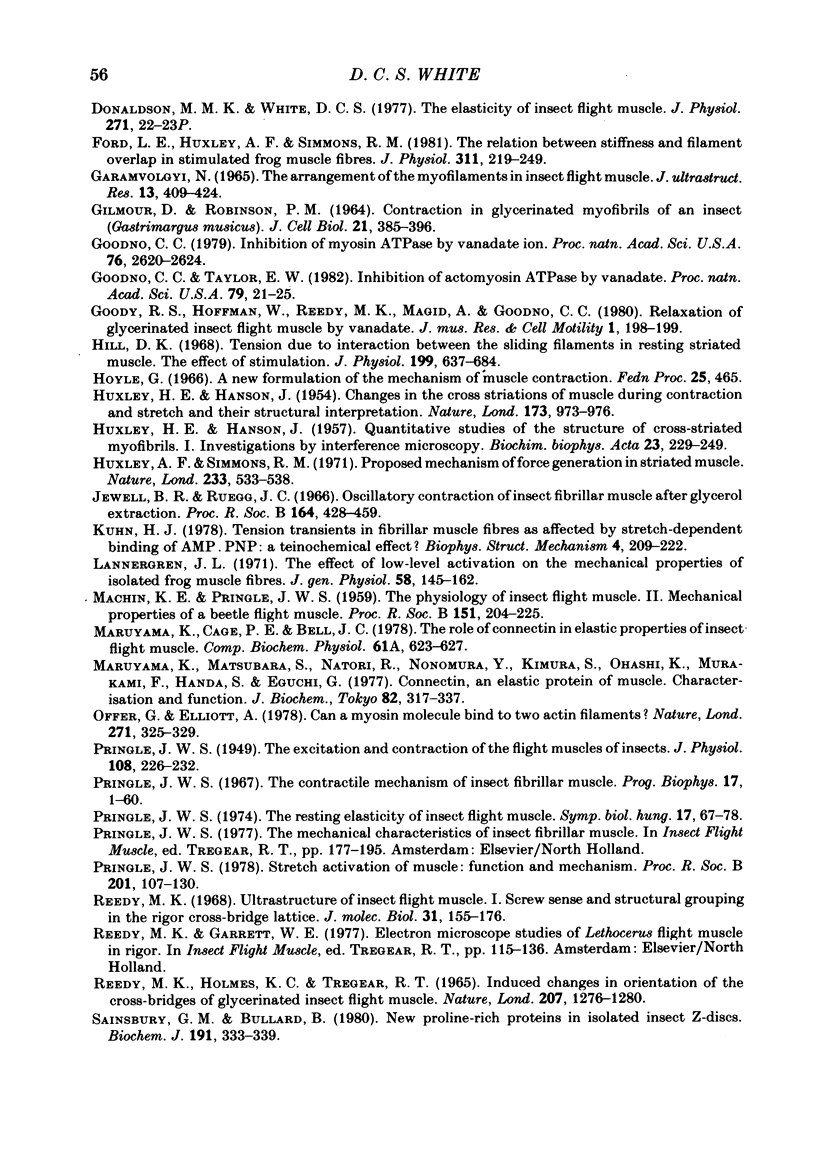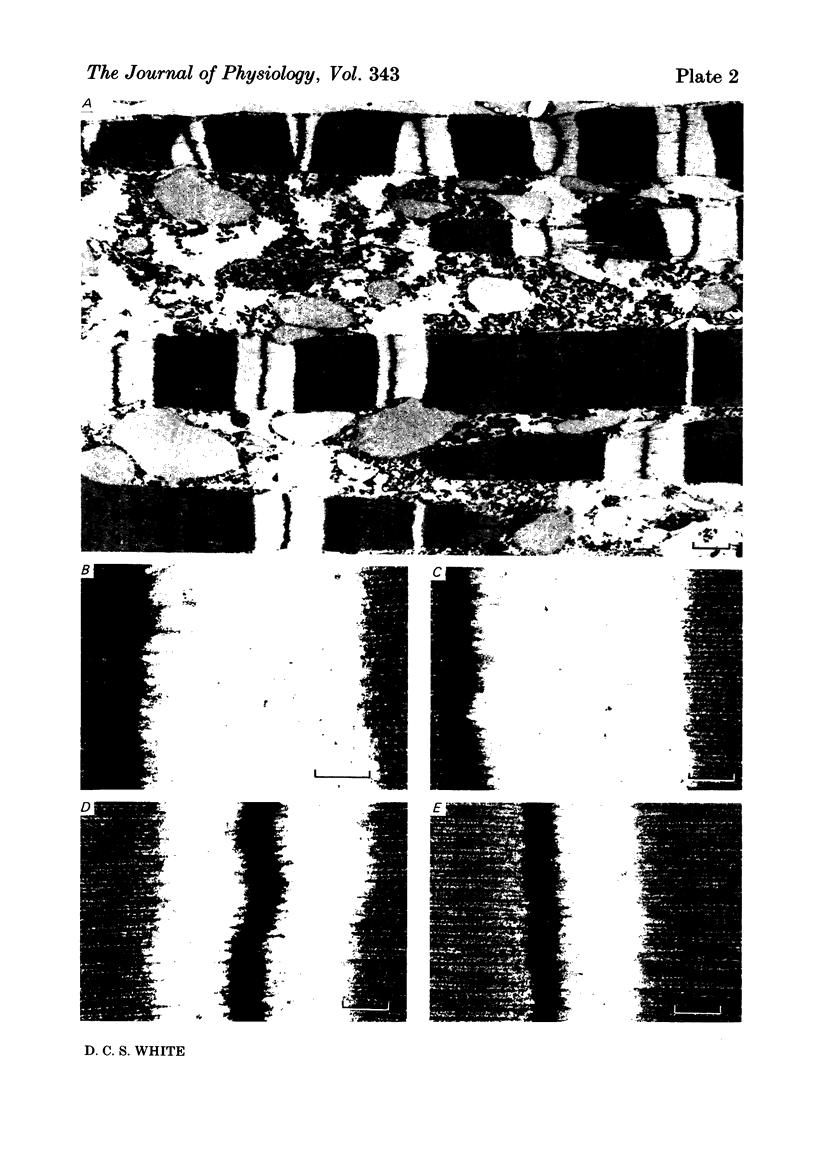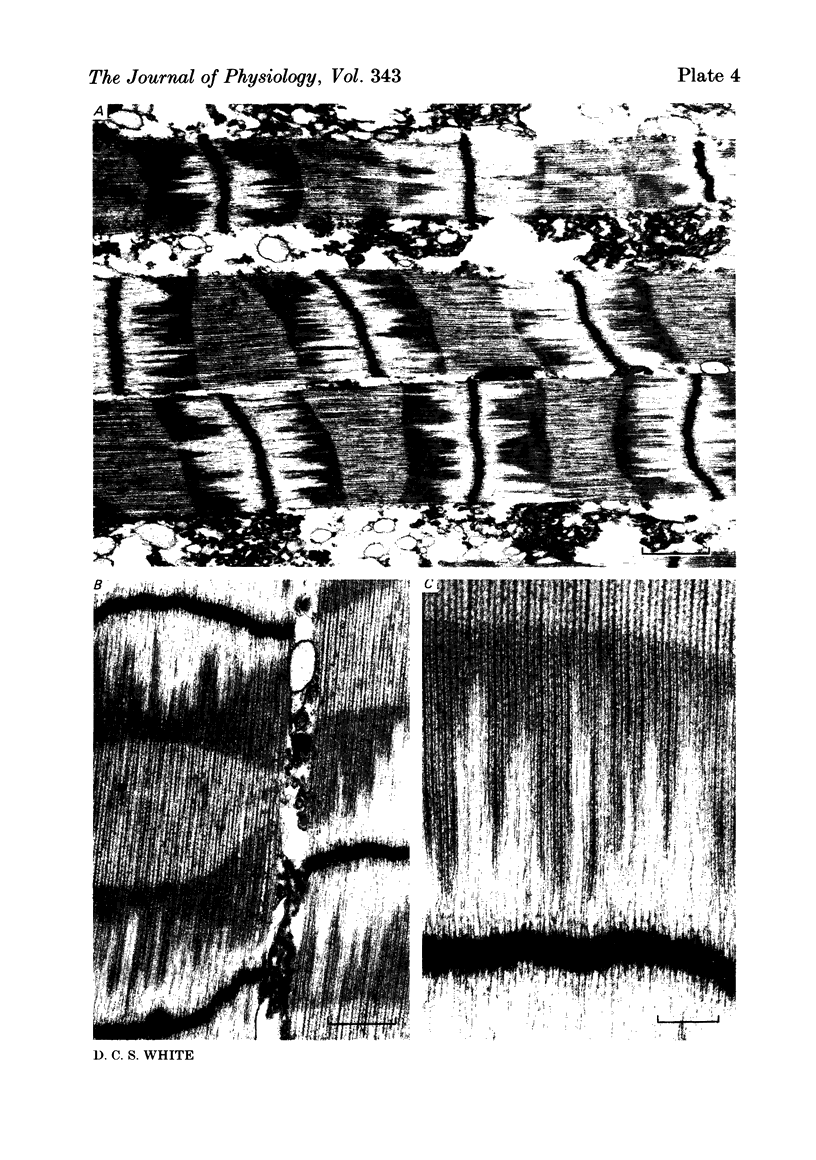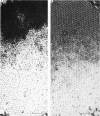Abstract
The mechanical properties of glycerol-extracted fibres from the dorsal longitudinal muscle of Lethocerus have been determined by sinusoidal and transient analysis in the time range 1 ms-1000 s, and from rest length to 10% strain for fibres in relaxing and rigor solutions. The fibres behave reversibly up to strains of about 5%, but reach an elastic limit in the range 5-9% strain, depending upon the rate of strain. Electron micrographs of fibres at different degrees of stretch, and after partial extraction of the contractile proteins, suggest that a connexion between the end of the A filament and the Z line, named a C filament, is responsible for the high stiffness of the relaxed muscle. Estimates are made of the compliance of the A, I and C filaments. The mechanical response of the relaxed muscle, over the entire frequency range studied, is assignable to the C filaments. An analysis of the stiffness of the fibres at different tensions in activating and relaxing solutions, and in fibres relaxed by orthovanadate, shows that the C filaments still exert their mechanical effect in the active muscle. That is, the response of the active muscle consists of the contribution from the cross-bridges plus that of the C filaments, acting mechanically in parallel. This situation is incompatible with earlier explanations of the fully activated mechanical dynamics of fibrillar muscle. Alternative explanations at the cross-bridge level are described in the paper that follows this one.
Full text
PDF






























Images in this article
Selected References
These references are in PubMed. This may not be the complete list of references from this article.
- Abbott R. H. The effects of fibre length and calcium ion concentration on the dynamic response of glycerol extracted insect fibrillar muscle. J Physiol. 1973 Jun;231(2):195–208. doi: 10.1113/jphysiol.1973.sp010228. [DOI] [PMC free article] [PubMed] [Google Scholar]
- Armitage P. M., Tregear R. T., Miller A. Effect of activation by calcium on the x-ray diffraction pattern from insect flight muscle. J Mol Biol. 1975 Feb 15;92(1):39–53. doi: 10.1016/0022-2836(75)90090-x. [DOI] [PubMed] [Google Scholar]
- Ashhurst D. E. The fibrillar flight muscles of giant water-bugs: an electron-microscope study. J Cell Sci. 1967 Sep;2(3):435–444. doi: 10.1242/jcs.2.3.435. [DOI] [PubMed] [Google Scholar]
- Bullard B., Hammond K. S., Luke B. M. The site of paramyosin in insect flight muscle and the presence of an unidentified protein between myosin filaments and Z-line. J Mol Biol. 1977 Sep 25;115(3):417–440. doi: 10.1016/0022-2836(77)90163-2. [DOI] [PubMed] [Google Scholar]
- Chaplain R. A., Tregear R. T. The mass of myosin per cross-bridge in insect fibrillar flight muscle. J Mol Biol. 1966 Nov 14;21(2):275–280. doi: 10.1016/0022-2836(66)90098-2. [DOI] [PubMed] [Google Scholar]
- Donaldson M. M., White D. C. The elasticity of insect flight muscle [proceedings]. J Physiol. 1977 Oct;271(2):22P–23P. [PubMed] [Google Scholar]
- Ford L. E., Huxley A. F., Simmons R. M. The relation between stiffness and filament overlap in stimulated frog muscle fibres. J Physiol. 1981 Feb;311:219–249. doi: 10.1113/jphysiol.1981.sp013582. [DOI] [PMC free article] [PubMed] [Google Scholar]
- Garamvölgyi N. The arrangement of the myofilaments in the insect flight muscle. I. J Ultrastruct Res. 1965 Dec;13(5):409–424. doi: 10.1016/s0022-5320(65)90004-3. [DOI] [PubMed] [Google Scholar]
- Gilmour D., Robinson P. M. CONTRACTION IN GLYCERINATED MYOFIBRILS OF AN INSECT (ORTHOPTERA, ACRIDIDAE). J Cell Biol. 1964 Jun 1;21(3):385–396. doi: 10.1083/jcb.21.3.385. [DOI] [PMC free article] [PubMed] [Google Scholar]
- Goodno C. C. Inhibition of myosin ATPase by vanadate ion. Proc Natl Acad Sci U S A. 1979 Jun;76(6):2620–2624. doi: 10.1073/pnas.76.6.2620. [DOI] [PMC free article] [PubMed] [Google Scholar]
- Goodno C. C., Taylor E. W. Inhibition of actomyosin ATPase by vanadate. Proc Natl Acad Sci U S A. 1982 Jan;79(1):21–25. doi: 10.1073/pnas.79.1.21. [DOI] [PMC free article] [PubMed] [Google Scholar]
- HUXLEY H. E., HANSON J. Quantitative studies on the structure of cross-striated myofibrils. I. Investigations by interference microscopy. Biochim Biophys Acta. 1957 Feb;23(2):229–249. doi: 10.1016/0006-3002(57)90325-6. [DOI] [PubMed] [Google Scholar]
- HUXLEY H., HANSON J. Changes in the cross-striations of muscle during contraction and stretch and their structural interpretation. Nature. 1954 May 22;173(4412):973–976. doi: 10.1038/173973a0. [DOI] [PubMed] [Google Scholar]
- Hill D. K. Tension due to interaction between the sliding filaments in resting striated muscle. The effect of stimulation. J Physiol. 1968 Dec;199(3):637–684. doi: 10.1113/jphysiol.1968.sp008672. [DOI] [PMC free article] [PubMed] [Google Scholar]
- Huxley A. F., Simmons R. M. Proposed mechanism of force generation in striated muscle. Nature. 1971 Oct 22;233(5321):533–538. doi: 10.1038/233533a0. [DOI] [PubMed] [Google Scholar]
- Kuhn H. J. Tension transients in fibrillar muscle fibres as affected by stretch-dependent binding of AMP-PNP: a teinochemical effect? Biophys Struct Mech. 1978 Jul 12;4(3):209–222. doi: 10.1007/BF02426086. [DOI] [PubMed] [Google Scholar]
- Lännergren J. The effect of low-level activation on the mechanical properties of isolated frog muscle fibers. J Gen Physiol. 1971 Aug;58(2):145–162. doi: 10.1085/jgp.58.2.145. [DOI] [PMC free article] [PubMed] [Google Scholar]
- Maruyama K., Matsubara S., Natori R., Nonomura Y., Kimura S. Connectin, an elastic protein of muscle. Characterization and Function. J Biochem. 1977 Aug;82(2):317–337. [PubMed] [Google Scholar]
- Offer G., Elliott A. Can a myosin molecule bind to two actin filaments? Nature. 1978 Jan 26;271(5643):325–329. doi: 10.1038/271325a0. [DOI] [PubMed] [Google Scholar]
- Pringle J. W. The Croonian Lecture, 1977. Stretch activation of muscle: function and mechanism. Proc R Soc Lond B Biol Sci. 1978 May 5;201(1143):107–130. doi: 10.1098/rspb.1978.0035. [DOI] [PubMed] [Google Scholar]
- Pringle J. W. The contractile mechanism of insect fibrillar muscle. Prog Biophys Mol Biol. 1967;17:1–60. doi: 10.1016/0079-6107(67)90003-x. [DOI] [PubMed] [Google Scholar]
- Reedy M. K., Holmes K. C., Tregear R. T. Induced changes in orientation of the cross-bridges of glycerinated insect flight muscle. Nature. 1965 Sep 18;207(5003):1276–1280. doi: 10.1038/2071276a0. [DOI] [PubMed] [Google Scholar]
- Reedy M. K. Ultrastructure of insect flight muscle. I. Screw sense and structural grouping in the rigor cross-bridge lattice. J Mol Biol. 1968 Jan 28;31(2):155–176. doi: 10.1016/0022-2836(68)90437-3. [DOI] [PubMed] [Google Scholar]
- Sainsbury G. M., Bullard B. New proline-rich proteins in isolated insect Z-discs. Biochem J. 1980 Nov 1;191(2):333–339. doi: 10.1042/bj1910333. [DOI] [PMC free article] [PubMed] [Google Scholar]
- Steiger J. G., Abbott R. H. Biochemical interpretation of tension transients produced by a four-state mechanical model. J Muscle Res Cell Motil. 1981 Sep;2(3):245–260. doi: 10.1007/BF00713264. [DOI] [PubMed] [Google Scholar]
- Thorson J., White D. C. Distributed representations for actin-myosin interaction in the oscillatory contraction of muscle. Biophys J. 1969 Mar;9(3):360–390. doi: 10.1016/S0006-3495(69)86392-7. [DOI] [PMC free article] [PubMed] [Google Scholar]
- Thorson J., White D. C. Dynamic force measurement at the microgram level, with application to myofibrils of striated muscle. IEEE Trans Biomed Eng. 1975 Jul;22(4):293–299. doi: 10.1109/tbme.1975.324447. [DOI] [PubMed] [Google Scholar]
- Trombitas K., Tigyi-Sebes A. The continuity of thick filaments between sarcomeres in honey bee flight muscle. Nature. 1979 Sep 27;281(5729):319–320. doi: 10.1038/281319a0. [DOI] [PubMed] [Google Scholar]
- Trombitás K., Tigyi-Sebes A. Direct evidence for connecting C filaments in flight muscle of honey bee. Acta Biochim Biophys Acad Sci Hung. 1974;9(3):243–253. [PubMed] [Google Scholar]
- Trombitás K., Tigyi-Sebes A. The Z line of the flight muscle of honey-bee. Acta Biochim Biophys Acad Sci Hung. 1975;10(1-2):83–93. [PubMed] [Google Scholar]
- White D. C. Rigor contraction and the effect of various phosphate compounds on glycerinated insect flight and vertebrate muscle. J Physiol. 1970 Jul;208(3):583–605. doi: 10.1113/jphysiol.1970.sp009138. [DOI] [PMC free article] [PubMed] [Google Scholar]







